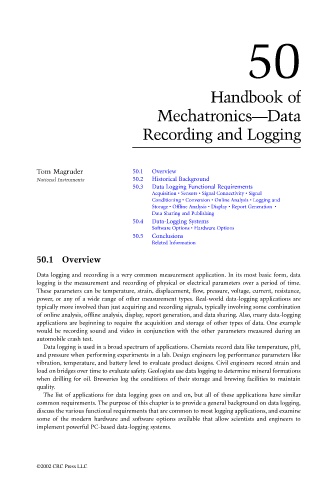Page 1223 - The Mechatronics Handbook
P. 1223
50
Handbook of
Mechatronics—Data
Recording and Logging
Tom Magruder 50.1 Overview
National Instruments 50.2 Historical Background
50.3 Data Logging Functional Requirements
Acquisition • Sensors • Signal Connectivity • Signal
Conditioning • Conversion • Online Analysis • Logging and
Storage • Offline Analysis • Display • Report Generation •
Data Sharing and Publishing
50.4 Data-Logging Systems
Software Options • Hardware Options
50.5 Conclusions
Related Information
50.1 Overview
Data logging and recording is a very common measurement application. In its most basic form, data
logging is the measurement and recording of physical or electrical parameters over a period of time.
These parameters can be temperature, strain, displacement, flow, pressure, voltage, current, resistance,
power, or any of a wide range of other measurement types. Real-world data-logging applications are
typically more involved than just acquiring and recording signals, typically involving some combination
of online analysis, offline analysis, display, report generation, and data sharing. Also, many data-logging
applications are beginning to require the acquisition and storage of other types of data. One example
would be recording sound and video in conjunction with the other parameters measured during an
automobile crash test.
Data logging is used in a broad spectrum of applications. Chemists record data like temperature, pH,
and pressure when performing experiments in a lab. Design engineers log performance parameters like
vibration, temperature, and battery level to evaluate product designs. Civil engineers record strain and
load on bridges over time to evaluate safety. Geologists use data logging to determine mineral formations
when drilling for oil. Breweries log the conditions of their storage and brewing facilities to maintain
quality.
The list of applications for data logging goes on and on, but all of these applications have similar
common requirements. The purpose of this chapter is to provide a general background on data logging,
discuss the various functional requirements that are common to most logging applications, and examine
some of the modern hardware and software options available that allow scientists and engineers to
implement powerful PC-based data-logging systems.
©2002 CRC Press LLC

